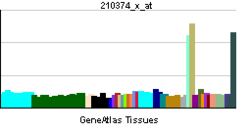Prostaglandin EP3 receptor
| View/Edit Human | View/Edit Mouse |
Prostaglandin E2 receptor 3 (EP3) is a prostaglandin receptor, encoded by the PTGER3 gene.[4]
Receptor
The receptor is a member of the G-protein coupled receptor family. It works through the G protein Gi, leading to a decrease in cytosolic cyclic AMP (cAMP). It is one of four receptors identified for prostaglandin E2 (PGE2). This receptor may have many biological functions, which involve digestion, nervous system, kidney reabsorption, and uterine contraction activities. In the stomach, it inhibits gastric acid secretions.
Studies of the mouse counterpart suggest that this receptor may also mediate adrenocorticotropic hormone response as well as fever generation in response to exogenous and endogenous stimuli.
Variations
Multiple alternatively spliced transcript variants encoding eight distinct isoforms have been reported.[4]
See also
- Prostaglandin E2 receptor 1 (EP1)
- Prostaglandin E2 receptor 2 (EP2)
- Prostaglandin E2 receptor 4 (EP4)
- Eicosanoid receptor
References
External links
- "Prostanoid Receptors: EP3". IUPHAR Database of Receptors and Ion Channels. International Union of Basic and Clinical Pharmacology.
Further reading
- Kotani M, Tanaka I, Ogawa Y, et al. (1995). "Molecular cloning and expression of multiple isoforms of human prostaglandin E receptor EP3 subtype generated by alternative messenger RNA splicing: multiple second messenger systems and tissue-specific distributions". Mol. Pharmacol. 48 (5): 869–79. PMID 7476918.
- Han X, Lan X, Li Q, Gao Y, Zhu W, Cheng T, Maruyama T, Wang J (2015). "Inhibition of prostaglandin E2 receptor EP3 mitigates thrombin-induced brain injury.". J Cereb Blood Flow Metab. doi:10.1177/0271678X15606462. PMID 26661165.
- Duncan AM, Anderson LL, Funk CD, et al. (1995). "Chromosomal localization of the human prostanoid receptor gene family". Genomics. 25 (3): 740–742. doi:10.1016/0888-7543(95)80022-E. PMID 7759114.
- Schmid A, Thierauch KH, Schleuning WD, Dinter H (1995). "Splice variants of the human EP3 receptor for prostaglandin E2". Eur. J. Biochem. 228 (1): 23–30. doi:10.1111/j.1432-1033.1995.tb20223.x. PMID 7883006.
- An S, Yang J, So SW, et al. (1995). "Isoforms of the EP3 subtype of human prostaglandin E2 receptor transduce both intracellular calcium and cAMP signals". Biochemistry. 33 (48): 14496–14502. doi:10.1021/bi00252a016. PMID 7981210.
- Regan JW, Bailey TJ, Donello JE, et al. (1994). "Molecular cloning and expression of human EP3 receptors: evidence of three variants with differing carboxyl termini". Br. J. Pharmacol. 112 (2): 377–85. doi:10.1111/j.1476-5381.1994.tb13082.x. PMC 1910333
 . PMID 8075855.
. PMID 8075855. - Yang J, Xia M, Goetzl EJ, An S (1994). "Cloning and expression of the EP3-subtype of human receptors for prostaglandin E2". Biochem. Biophys. Res. Commun. 198 (3): 999–1006. doi:10.1006/bbrc.1994.1142. PMID 8117308.
- Kunapuli SP, Fen Mao G, Bastepe M, et al. (1994). "Cloning and expression of a prostaglandin E receptor EP3 subtype from human erythroleukaemia cells". Biochem. J. 298 (2): 263–7. PMC 1137934
 . PMID 8135729.
. PMID 8135729. - Adam M, Boie Y, Rushmore TH, et al. (1994). "Cloning and expression of three isoforms of the human EP3 prostanoid receptor". FEBS Lett. 338 (2): 170–174. doi:10.1016/0014-5793(94)80358-7. PMID 8307176.
- Chang C, Negishi M, Nishigaki N, Ichikawa A (1997). "Functional interaction of the carboxylic acid group of agonists and the arginine residue of the seventh transmembrane domain of prostaglandin E receptor EP3 subtype". Biochem. J. 322 (2): 597–601. PMC 1218231
 . PMID 9065782.
. PMID 9065782. - Kotani M, Tanaka I, Ogawa Y, et al. (1997). "Structural organization of the human prostaglandin EP3 receptor subtype gene (PTGER3)". Genomics. 40 (3): 425–434. doi:10.1006/geno.1996.4585. PMID 9073510.
- Ushikubi F, Segi E, Sugimoto Y, et al. (1998). "Impaired febrile response in mice lacking the prostaglandin E receptor subtype EP3". Nature. 395 (6699): 281–284. doi:10.1038/26233. PMID 9751056.
- Bhattacharya M, Peri K, Ribeiro-da-Silva A, et al. (1999). "Localization of functional prostaglandin E2 receptors EP3 and EP4 in the nuclear envelope". J. Biol. Chem. 274 (22): 15719–15724. doi:10.1074/jbc.274.22.15719. PMID 10336471.
- Liu J, Akahoshi T, Jiang S, et al. (2000). "Induction of neutrophil death resembling neither apoptosis nor necrosis by ONO-AE-248, a selective agonist for PGE2 receptor subtype 3". J. Leukoc. Biol. 68 (2): 187–93. PMID 10947062.
- Kurihara Y, Endo H, Kondo H (2001). "Induction of IL-6 via the EP3 subtype of prostaglandin E receptor in rat adjuvant-arthritic synovial cells". Inflamm. Res. 50 (1): 1–5. doi:10.1007/s000110050716. PMID 11235015.
- Strausberg RL, Feingold EA, Grouse LH, et al. (2003). "Generation and initial analysis of more than 15,000 full-length human and mouse cDNA sequences". Proc. Natl. Acad. Sci. U.S.A. 99 (26): 16899–16903. doi:10.1073/pnas.242603899. PMC 139241
 . PMID 12477932.
. PMID 12477932. - Matsuoka Y, Furuyashiki T, Bito H, et al. (2003). "Impaired adrenocorticotropic hormone response to bacterial endotoxin in mice deficient in prostaglandin E receptor EP1 and EP3 subtypes". Proc. Natl. Acad. Sci. U.S.A. 100 (7): 4132–4137. doi:10.1073/pnas.0633341100. PMC 153060
 . PMID 12642666.
. PMID 12642666. - Wing DA, Goharkhay N, Hanna M, et al. (2003). "EP3-2 receptor mRNA expression is reduced and EP3-6 receptor mRNA expression is increased in gravid human myometrium". J. Soc. Gynecol. Investig. 10 (3): 124–129. doi:10.1016/S1071-5576(03)00007-8. PMID 12699873.
- Abulencia JP, Gaspard R, Healy ZR, et al. (2003). "Shear-induced cyclooxygenase-2 via a JNK2/c-Jun-dependent pathway regulates prostaglandin receptor expression in chondrocytic cells". J. Biol. Chem. 278 (31): 28388–28394. doi:10.1074/jbc.M301378200. PMID 12743126.
- Richards JA, Brueggemeier RW (2003). "Prostaglandin E2 regulates aromatase activity and expression in human adipose stromal cells via two distinct receptor subtypes". J. Clin. Endocrinol. Metab. 88 (6): 2810–2816. doi:10.1210/jc.2002-021475. PMID 12788892.
- Moreland RB, Kim N, Nehra A, et al. (2004). "Functional prostaglandin E (EP) receptors in human penile corpus cavernosum". Int. J. Impot. Res. 15 (5): 362–368. doi:10.1038/sj.ijir.3901042. PMID 14562138.
This article incorporates text from the United States National Library of Medicine, which is in the public domain.


